Eyebrow Transplant in Turkey: Shape Planning, Density Targets & Aftercare
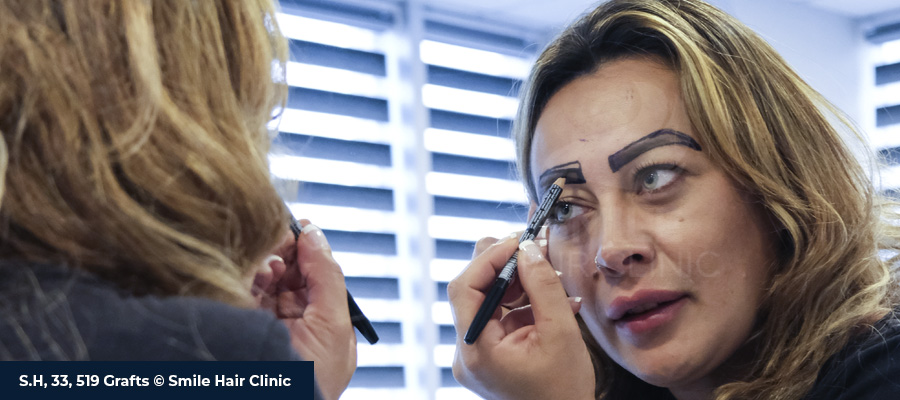
Publish Date: 10 October 2025
The eyebrow transplant in Turkey has become one of the most sought-after cosmetic procedures for both men and women who want to achieve natural, symmetrical brows. The appeal is clear: Turkey offers world-class medical expertise, competitive pricing, and surgeons skilled in precise eyebrow shape design and density control.
Unlike microblading or temporary tattooing, an eyebrow hair transplant Turkey provides a permanent solution. It uses your own natural hair follicles to rebuild the brow area, creating soft, authentic growth that matches your facial structure. This makes it an ideal choice for people with thin, over-plucked, or uneven eyebrows caused by genetics, trauma, or medical conditions.
Modern clinics across Istanbul and Ankara now perform advanced DHI eyebrow transplant and FUE eyebrow transplant techniques, ensuring natural direction, accurate density, and minimal scarring. The procedure focuses on eyebrow design planning, eyebrow density per cm², and follicular angle alignment, ensuring results that suit the face perfectly.
“Eyebrow restoration is not only about filling gaps. It is about shaping a natural frame that enhances the eyes and balances overall facial harmony.” — Dr. Gökay Bilgin
With a growing number of patients traveling for eyebrow restoration Turkey procedures, the country has set a global benchmark for both artistic design and medical precision. Clinics here offer complete treatment packages that include pre-operative consultation, accommodation, and personalized eyebrow transplant aftercare.
This article covers every aspect of the procedure, including design principles, eyebrow transplant recovery, costs, and realistic expectations for eyebrow transplant results. Whether you are considering this treatment for the first time or comparing techniques, you will find all the essential insights to plan your journey confidently.
Anatomy & Design – Planning the Perfect Brow
The success of an eyebrow transplant in Turkey begins long before the first graft is placed. It starts with meticulous eyebrow design planning, where each curve, angle, and density target is determined according to the patient’s facial symmetry and expression. The goal is to create brows that enhance the eyes while maintaining a completely natural look.
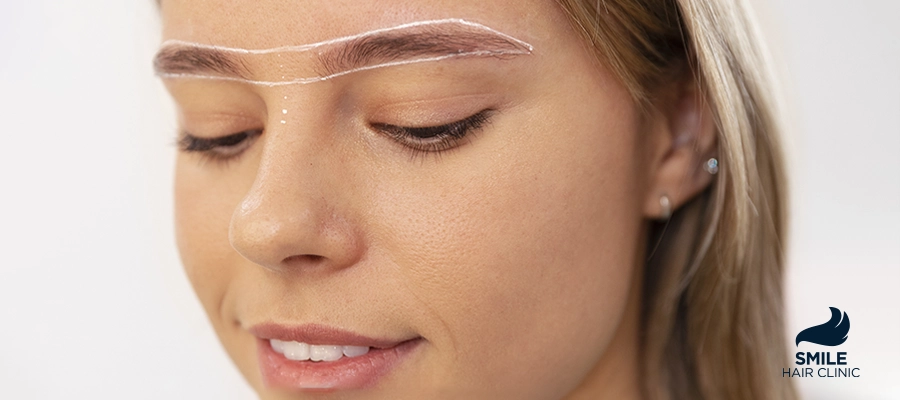
About Eyebrow Zones
Each eyebrow consists of three primary zones, and each has its own growth direction and thickness pattern:
- Head: The inner section closest to the nose, where hair grows vertically or slightly upward.
- Arch: The central, most prominent part where the curve forms. Density and angle are carefully adjusted here for balance.
- Tail: The outer end of the brow, where hair gradually thins for a softer finish.
A surgeon performing eyebrow hair transplant Turkey maps these zones using digital or manual eyebrow shape mapping techniques to ensure proportionality between the left and right sides. This step defines not only the overall shape but also the eyebrow angle and direction, which are crucial for natural results.
Density & Direction
Ideal eyebrow density per cm² typically ranges from 150 to 300 grafts, depending on individual preference and facial structure. The surgeon adjusts each single-hair graft with precise follicular angle alignment, ensuring hairs sit flush with the skin and follow natural growth direction.
Design Personalization
Factors such as gender, ethnicity, and facial contour influence design preferences. For example:
- Women generally prefer soft, arched shapes with moderate thickness.
- Men often choose straighter, denser brows for a defined but natural look.
“A natural eyebrow design follows the patient’s bone structure and muscle movement. Copying one pattern for everyone leads to unnatural symmetry.” — Dr. Mehmet Erdoğan
This phase sets the foundation for every other step, from graft extraction to implantation. Once the eyebrow shape design and density are finalized, the surgeon can proceed with precise graft harvesting and implantation techniques that will maintain the planned curvature and direction over time.
Candidate Suitability & Pre-Operation Assessment
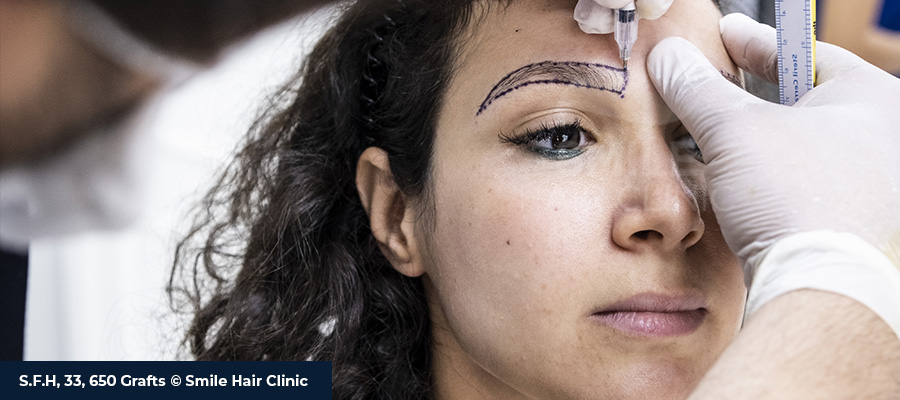
Before undergoing an eyebrow transplant in Turkey, patients are carefully evaluated to determine suitability. This assessment ensures that the final results meet expectations and that the procedure is both safe and effective.
Ideal Candidates for Eyebrow Transplant
A good candidate for an eyebrow hair transplant Turkey typically fits the following criteria:
- Has thin, sparse, or missing eyebrows due to genetics, scarring, or over-plucking.
- Possesses a healthy donor area on the scalp, usually from the back or sides of the head.
- Maintains stable hormonal and skin conditions with no active infections or dermatitis.
- Understands the process and has realistic expectations regarding density, direction, and shape.
Patients with previous injuries or burns that damaged the brow area are also excellent candidates for natural eyebrow restoration, as this technique restores both appearance and confidence.
Donor Hair Evaluation
The donor hair is selected based on similarity to natural eyebrow hair in texture, thickness, and color. Surgeons prefer fine hairs from behind the ears or the nape region because they best mimic natural brow strands. The follicular unit extraction (FUE) or direct hair implantation (DHI) method is used to extract single-hair grafts gently, preserving their integrity and maximizing the graft survival rate.
Pre-Operation Planning
Before surgery, each patient undergoes a personalized consultation that includes:
- Eyebrow shape mapping and design simulation.
- Estimation of graft count based on eyebrow density per cm².
- Photography to document the pre-operative stage.
- Detailed explanation of post-op expectations, swelling phases, and the eyebrow transplant recovery timeline.
Patients are typically advised to avoid smoking, alcohol, and blood-thinning medications for one week before the procedure to minimize localized edema and post-operative inflammation.
“Pre-operative planning is the blueprint of success. Every graft should have a purpose, placed in harmony with facial lines and natural muscle movement.” — Dr. Gökay Bilgin
This preparatory stage ensures that both the surgeon and patient share a clear understanding of the desired outcome before proceeding with the implantation phase.
Techniques & Implantation Strategies
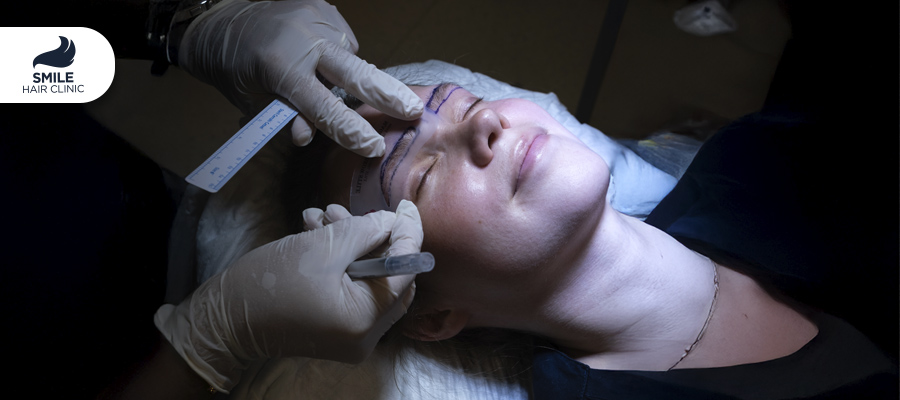
Modern eyebrow transplant in Turkey procedures rely on refined techniques that prioritize precision, density control, and natural texture. Two main methods dominate this field — FUE (Follicular Unit Extraction) and DHI (Direct Hair Implantation) — both capable of creating authentic, long-lasting results with minimal recovery time.
FUE Eyebrow Transplant
In FUE eyebrow transplant, individual single-hair grafts are extracted from the donor area using micro-punch tools and then implanted manually into the recipient zones. The surgeon first opens micro-channels at a shallow angle to ensure the grafts follow natural eyebrow angle and direction.
Advantages:
- High graft survival rate
- Minimal scarring
- Excellent control over density and orientation
- Cost-effective for medium-to-large graft sessions
Ideal for: Patients requiring full eyebrow restoration Turkey or major reshaping of the brow line.
DHI Eyebrow Transplant
The DHI eyebrow transplant takes precision one step further. Using a Choi implanter pen, grafts are extracted and implanted simultaneously without the need to pre-open channels. This allows the surgeon to adjust angle, depth, and direction with micro-level accuracy in real time.
Advantages:
- Superior control over graft placement
- Reduced trauma and faster healing
- Shorter surgery time
- Higher consistency in shape and alignment
Ideal for: Patients seeking subtle enhancements, shape correction, or denser coverage in specific zones.
Implantation Strategy
During implantation, the surgeon follows the micrograft technique, ensuring each graft sits flat against the skin to mimic natural brow hair. The direction of implantation changes slightly between the inner brow (vertical) and the arch or tail (horizontal to oblique). This attention to follicular angle alignment ensures perfect blending and avoids unnatural stiffness.
To prevent complications like post-operative inflammation or follicle misalignment, surgeons perform the procedure under magnification, using gentle handling and sterile tools.
“Each brow is designed like a canvas. DHI gives surgeons the freedom to adjust every hair’s angle on the spot, resulting in perfect texture and definition.” — Dr. Mehmet Erdoğan
Both methods offer excellent outcomes, but the final choice depends on the patient’s goals, donor availability, and the surgeon’s expertise. Many leading Turkish clinics combine both FUE and DHI for optimal precision and density control.
Cost Breakdown & Pricing Models
Turkey is recognized as one of the most affordable destinations for cosmetic surgery, and eyebrow transplant cost Turkey remains significantly lower than in Europe or the United States. Yet, affordability does not mean compromise. Clinics across Istanbul, Ankara, and Izmir combine advanced medical equipment with experienced surgeons who specialize in detailed eyebrow restoration Turkey procedures.
Factors That Affect Eyebrow Transplant Cost
The final price varies depending on several key factors:
- Technique Used: DHI procedures are generally more expensive than FUE due to the use of implanter pens and surgeon-led implantation.
- Graft Count: The number of grafts determines overall cost, as pricing is often calculated per graft.
- Clinic Reputation: Renowned clinics with high patient satisfaction and international accreditation may charge slightly more.
- Surgeon Expertise: The surgeon’s experience in eyebrow design planning and aesthetic balance directly affects pricing.
- Package Inclusions: Most clinics offer all-inclusive eyebrow transplant package Turkey options with accommodation, transfers, and aftercare.
Average Price Range
| Procedure Type | Technique | Average Grafts | Price Range (USD) | Inclusions |
|---|---|---|---|---|
| FUE Eyebrow Transplant | FUE | 200–400 | $1,000–$1,400 | Basic aftercare |
| DHI Eyebrow Transplant | DHI | 200–400 | $1,200–$1,800 | Surgeon-led implantation |
| Premium Eyebrow Design & Density | DHI + PRP | 400–500 | $1,800–$2,200 | PRP, hotel, transfers |
These prices are significantly lower than Western countries, where eyebrow transplants can cost between $3,000 and $6,000. Patients looking for an affordable eyebrow transplant Turkey find exceptional value without sacrificing safety or quality.
Cost Comparison: Turkey vs. Other Countries
| Country | Average Cost (USD) | Technique | Grafts Included |
|---|---|---|---|
| Turkey | $1,200–$1,800 | FUE / DHI | 300–400 |
| UK | $3,000–$4,500 | FUE | 300 |
| USA | $4,000–$6,000 | FUE / FUT | 300–400 |
| Germany | $3,500–$5,000 | FUE | 350 |
Choosing Turkey offers not just lower cost per graft eyebrow transplant, but also access to leading specialists who focus on natural eyebrow restoration and precise eyebrow shape design.
“Turkey’s clinics stand out because they deliver both artistry and medical excellence at an accessible cost. The balance between design and affordability makes it a global hub for eyebrow restoration.” — Dr. Gökay Bilgin
For patients comparing options, the best approach is to focus on surgeon skill and artistic design rather than simply finding the best price eyebrow transplant Turkey.
Recovery & Healing Timeline (Day-by-Day)
After an eyebrow transplant in Turkey, recovery is typically smooth and predictable. Thanks to advanced FUE and DHI methods, swelling, redness, and discomfort are minimal. Following proper eyebrow transplant aftercare tips ensures faster healing, better graft survival, and natural long-term growth.
Day 0–3: Initial Healing Phase
Immediately after surgery, the eyebrow area may appear slightly swollen and red. Small crusts form around each graft, which is completely normal. This is the body’s natural healing response and protects the implanted follicles. Patients should avoid washing or touching the area during this period.
Mild eyebrow transplant swelling or localized edema may appear, especially around the eyelids, but it subsides within a few days. Sleeping with the head elevated helps minimize this.
Day 4–7: Scab Shedding and Cleansing
The scabs begin to soften and fall off gradually. At this stage, gentle washing with a saline solution or a mild baby shampoo may be started according to your clinic’s eyebrow transplant washing instructions. Avoid scratching or rubbing the area, as the new follicles are still stabilizing.
Redness and tightness will start to fade, and you can resume light daily activities.
Week 2–4: Shock Loss and Skin Recovery
Around week two, some transplanted hairs may shed during the shock loss phase, which is entirely normal. The follicles remain alive beneath the skin and will enter a new regrowth cycle.
Patients should continue following post-op eyebrow care routine guidelines and avoid direct sunlight, saunas, and heavy exercise until the skin barrier has fully recovered.
Month 2–4: Regrowth Phase Begins
New hairs start appearing slowly. During this period, the brows may look uneven as different follicles grow at different speeds. This stage requires patience, as the eyebrow regrowth timeline varies among individuals.
Month 6–12: Final Results and Density
By month six, visible growth is well underway, and most patients enjoy noticeable improvements in texture and fullness. The final eyebrow transplant results are typically seen between 9 and 12 months, when the density stabilizes and the transplanted hairs can be shaped and trimmed normally.
Recovery Summary Table
| Stage | Timeline | What to Expect | Care Instructions |
|---|---|---|---|
| Initial Healing | Day 0–3 | Swelling, scabbing, mild redness | Keep area dry, sleep elevated |
| Scab Shedding | Day 4–7 | Scabs soften and fall off | Begin gentle washing |
| Shock Loss Phase | Week 2–4 | Temporary hair shedding | Avoid scratching and sun exposure |
| Regrowth Phase | Month 2–4 | New hairs start emerging | Stay consistent with aftercare |
| Full Recovery | Month 6–12 | Final density and shape visible | Normal trimming and styling allowed |
“The key to natural results is patience. Once the growth cycle begins, every new strand contributes to the brow’s final texture and symmetry.” — Dr. Mehmet Erdoğan
Outcomes, Risks & Revisions
The outcome of an eyebrow transplant in Turkey depends on the surgeon’s expertise, the chosen technique, and the patient’s aftercare routine. With modern DHI and FUE methods, the results are permanent, natural, and customizable for each facial type.
Expected Results
A successful eyebrow hair transplant Turkey provides a lifelong improvement in density, shape, and symmetry. After the first few months of the eyebrow regrowth timeline, new hairs begin to follow natural growth cycles. Once matured, they can be trimmed and styled like native brows.
By 9–12 months post-surgery, most patients achieve their final eyebrow transplant results, showing full coverage and realistic direction. The implanted hairs continue to grow just like scalp hair, meaning occasional trimming is necessary to maintain shape.
The average graft survival rate in reputable Turkish clinics exceeds 90 percent, thanks to careful handling and follicular angle alignment during implantation.
Possible Risks and Complications
While the procedure is minimally invasive, minor side effects may appear during early recovery. These include:
- Temporary redness and swelling: Common in the first few days after surgery.
- Folliculitis or mild irritation: Can occur as new hairs begin growing; easily managed with prescribed creams.
- Uneven growth: Natural during the first few months until all follicles enter the same growth phase.
- Shock loss: A temporary shedding phase that resolves within weeks.
Severe complications are rare when performed by experienced surgeons, but neglecting proper eyebrow transplant aftercare may delay healing or slightly affect density.
Revision and Enhancement Options
In some cases, a small touch-up may be recommended to refine eyebrow shape design or fill minor gaps that appear after full healing. Revisions are usually minor and can be done 10–12 months post-surgery.
“Eyebrow transplants are a permanent solution, but artistic symmetry takes patience. Sometimes a few micrografts make all the difference between good and exceptional.” — Dr. Gökay Bilgin
A qualified surgeon will analyze every factor—skin type, vascular health, donor quality—to ensure natural direction and consistency in every strand.
With proper planning and realistic expectations, the risk of complications is extremely low, and the satisfaction rate among eyebrow restoration Turkey patients remains remarkably high.
Case Studies & Gallery
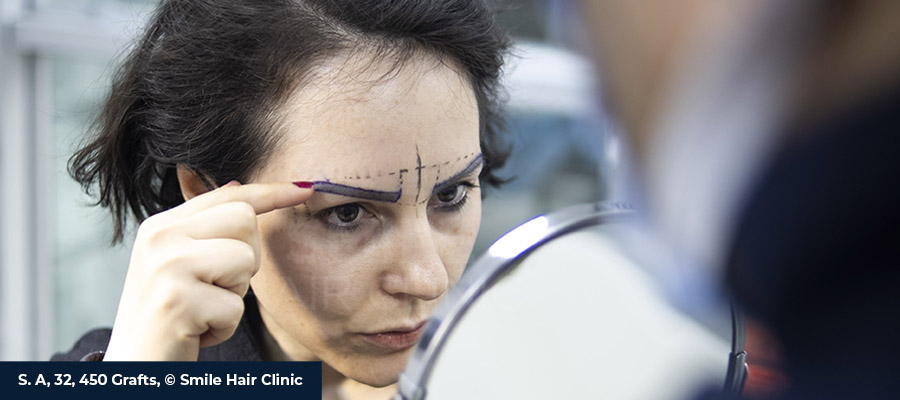
Real-world examples show how an eyebrow transplant in Turkey can restore balance and confidence through artistry and science. Each procedure is personalized based on facial symmetry, skin type, and desired density. Below are three case studies that illustrate how design and technique come together for exceptional eyebrow transplant results.
Case Study 1 – Full Brow Reconstruction with DHI
A 34-year-old woman with over-plucked brows desired a soft, natural look. She underwent a DHI eyebrow transplant with single-hair grafts taken from behind the ears to match fine texture.
- Technique: DHI
- Grafts Used: 420
- Goal: Full reconstruction with moderate arch
- Outcome: Natural density and direction visible by month 4, full results at month 10
“DHI gives surgeons the control needed to place every graft in harmony with the natural curve of the brow.” — Dr. Mehmet Erdoğan
Case Study 2 – Scar Correction Using FUE
A 29-year-old man sought eyebrow restoration Turkey to cover a small scar from an old injury. The surgeon performed a targeted FUE eyebrow transplant using 180 grafts to fill only the affected zone.
- Technique: FUE
- Grafts Used: 180
- Goal: Blend scar with natural brow texture
- Outcome: Complete coverage, no visible scar line after 8 months
This case highlights how micrograft technique and precise follicular angle alignment allow surgeons to work effectively even in limited areas.
Case Study 3 – Density Enhancement for Thinning Brows
A 40-year-old patient wanted thicker brows with subtle enhancement rather than full reconstruction. A DHI eyebrow transplant was chosen for controlled implantation and perfect eyebrow density per cm².
- Technique: DHI
- Grafts Used: 300
- Goal: Increase thickness without altering shape
- Outcome: Fuller yet natural results by month 6, complete recovery within 10 days
Case Summary Table
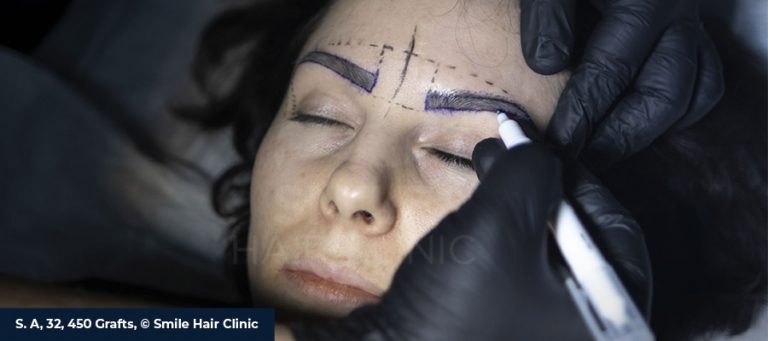
| Case | Technique | Grafts Used | Goal | Visible Results | Final Outcome |
|---|---|---|---|---|---|
| 1 | DHI | 420 | Full brow reconstruction | 4 months | Soft, defined brows |
| 2 | FUE | 180 | Scar correction | 8 months | Smooth texture blend |
| 3 | DHI | 300 | Density enhancement | 6 months | Thick, natural shape |
All cases achieved more than 90% graft survival rate and high patient satisfaction. These examples reflect the artistic precision Turkish surgeons apply in eyebrow transplant shape design, transforming sparse or uneven brows into natural, expressive features.
FAQs & Troubleshooting
How many grafts are needed for an eyebrow transplant?
An eyebrow transplant in Turkey typically requires between 200 and 500 grafts per eyebrow, depending on thickness and desired density. Patients needing full reconstruction may require more grafts, while small touch-ups can be achieved with fewer than 200.
Is eyebrow transplant permanent?
Yes. The transplanted follicles are taken from the scalp’s permanent zone, meaning the results of an eyebrow hair transplant Turkey are lifelong. Once healed, the hairs will continue to grow naturally, requiring only occasional trimming.
When does eyebrow transplant start growing?
Early regrowth begins around 2–3 months after surgery. Visible results appear by month 6, with final eyebrow transplant results seen between 9–12 months as all follicles enter the active growth phase.
Can eyebrow transplant be done with DHI?
Absolutely. DHI eyebrow transplant is one of the most advanced techniques available. It allows precise implantation without pre-made incisions, making it ideal for defining shape and direction in small areas.
How much does eyebrow transplant cost in Turkey?
The average eyebrow transplant cost Turkey ranges from $1,000 to $1,800, depending on technique (FUE or DHI), graft count, and clinic reputation. Packages often include accommodation and post-care.
What is the healing time for eyebrow transplant?
The full eyebrow transplant recovery timeline lasts about 10–14 days for healing and up to a year for full regrowth. Most patients return to normal routines within one week.
When can I wash my eyebrows after transplant?
Gentle washing can begin on day 4 or 5, following clinic-specific eyebrow transplant washing instructions. Always use mild, pH-balanced cleansers and avoid rubbing or scrubbing the graft area.
Can eyebrow transplant fail?
Failure is rare in skilled hands. Low graft survival usually occurs from poor technique or neglecting eyebrow transplant aftercare. In Turkey’s top clinics, the graft survival rate averages above 90 percent.
How to design a natural eyebrow shape?
Natural eyebrow shape design follows your bone structure, eye spacing, and facial symmetry. Surgeons use eyebrow shape mapping to plan angles, curvature, and density for personalized results.
What should I avoid after eyebrow transplant?
Avoid scratching, sun exposure, swimming, and heavy exercise for at least 10 days. Refrain from applying makeup or creams unless advised by your clinic. Proper post-op eyebrow care routine ensures a smooth recovery.
Conclusion
An eyebrow transplant in Turkey is more than a cosmetic enhancement — it is a meticulous restoration process that blends art, precision, and medical expertise. Whether performed using DHI or FUE, this procedure allows patients to achieve natural, symmetrical, and permanent eyebrows that complement their facial features.
From the initial eyebrow design planning to the final eyebrow transplant results, every step focuses on balance and realism. The process begins with detailed eyebrow shape mapping, continues with precision implantation using single-hair grafts, and ends with patient-specific eyebrow transplant aftercare that ensures long-term success.
- Techniques: DHI offers maximum accuracy for shape and direction, while FUE ensures efficient graft harvesting.
- Design: Proper eyebrow shape design is based on individual facial structure, ensuring natural outcomes.
- Density: Average eyebrow density per cm² ranges from 150–300 grafts for optimal fullness.
- Cost: The eyebrow transplant cost Turkey averages between $1,000 and $1,800 — far lower than in Europe or the US.
- Recovery: Most patients complete the eyebrow transplant recovery timeline within two weeks, with visible results appearing after a few months.
“Eyebrow transplantation is not about perfection. It’s about harmony — restoring balance that highlights your natural expression.” — Dr. Mehmet Erdoğan
At Smile Hair Clinic, eyebrow restoration is performed with the same precision and artistic vision that define all of our procedures. Our team of experienced surgeons specializes in eyebrow hair transplant Turkey techniques that deliver lasting, natural results while maintaining patient comfort and safety.
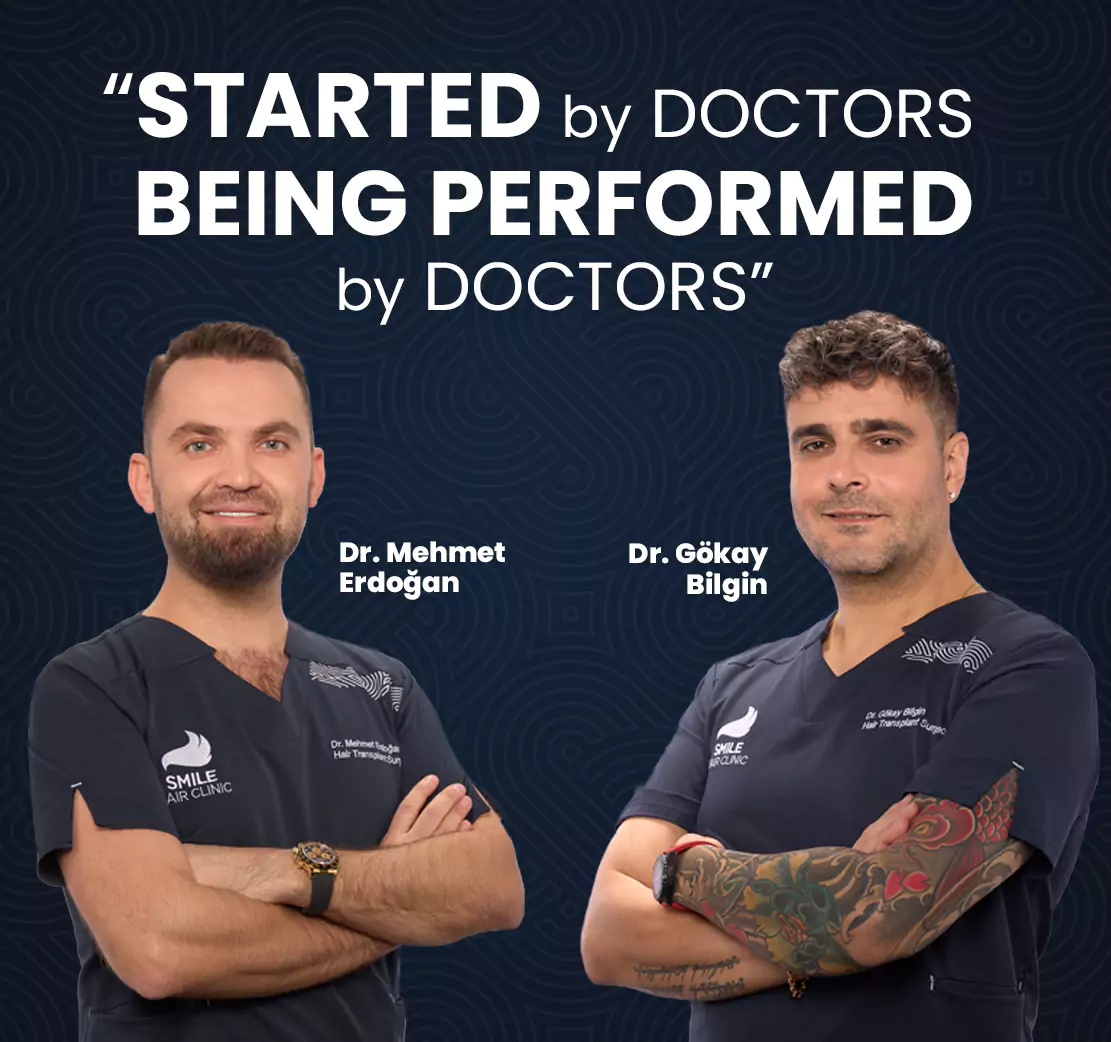
Every treatment begins with an in-depth consultation to plan your ideal eyebrow shape design based on face symmetry, density goals, and donor quality. With advanced DHI and FUE methods, we ensure minimal downtime, fast recovery, and authentic growth.
If you are considering eyebrow restoration Turkey, our clinic offers transparent pricing, tailored packages, and comprehensive support throughout your journey. Contact us today to schedule a personalized consultation and take the first step toward naturally fuller, beautifully shaped eyebrows.
Last Update: 10 October 2025
 Whatsapp
Whatsapp